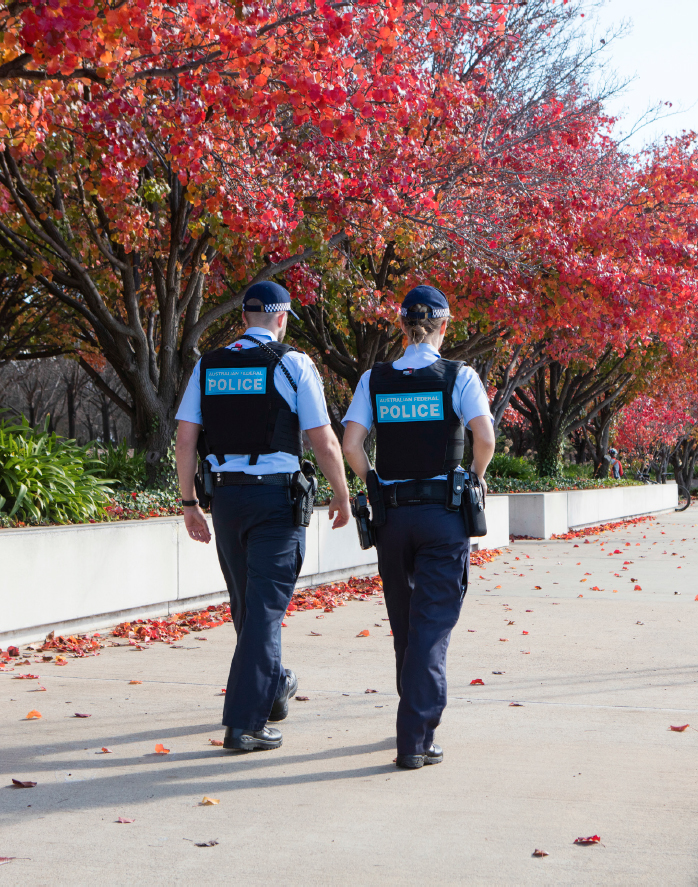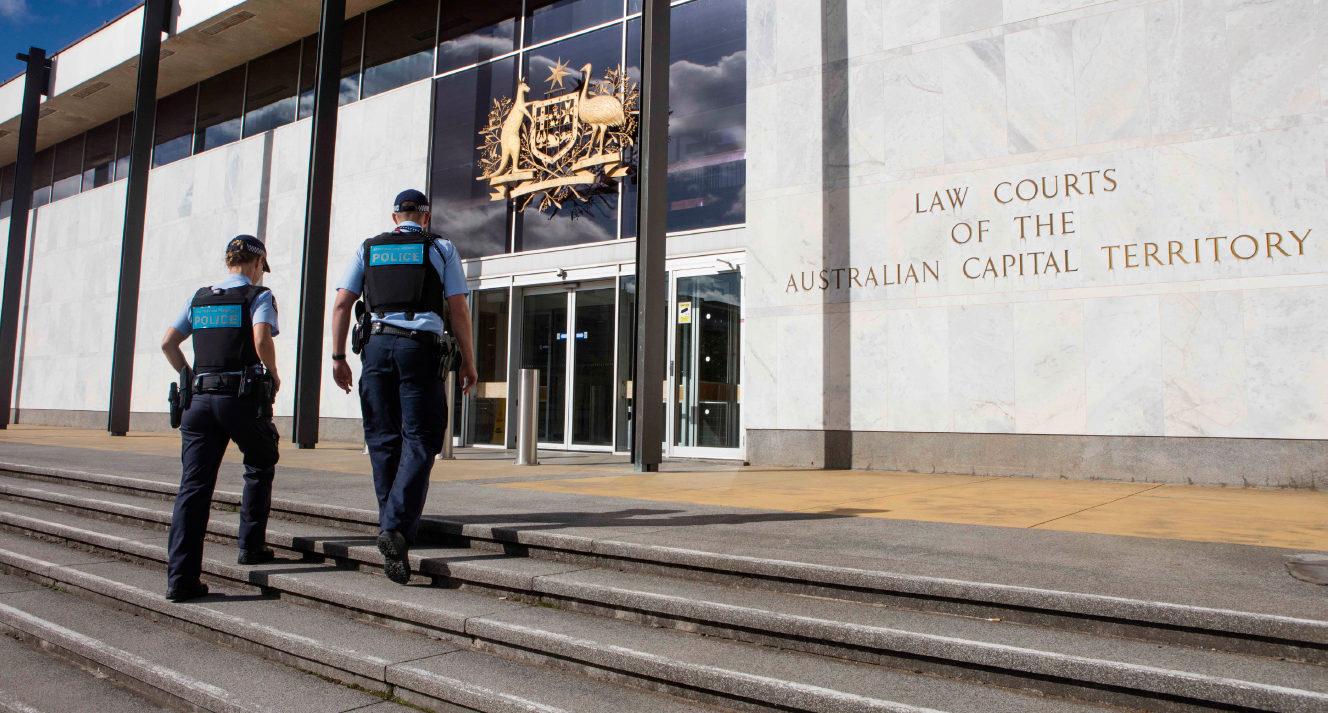ACT Policing - Special Purposes Annual Report 2018-19 (AG)

CHIEF POLICE OFFICER FOR THE ACT
RAY JOHNSON APM
GPO Box 401 Canberra City ACT 2601
Telephone: 02 5127 4015
Email: CPOACT@afp.gov.au
afp.gov.au
ABN 17 864 931 143
09 September 2019
Attorney-General
ACT Legislative Assembly
London Circuit
CANBERRA ACT 2600
Dear Attorney-General,
I am pleased to submit ACT Policing’s Special Purposes Annual Report for the financial year 1 July 2018 to 30 June 2019.
The report has been prepared in accordance with:
- section 258 of the Confiscation of Criminal Assets Act 2003
- section 38 of the Crimes (Assumed Identities) Act 2009
- section 21 of the Crimes (Protection of Witness Identity) Act 2011
I hereby certify that the attached Annual Report is an honest and accurate account of matters required under the above mentioned Acts.
I understand a copy of this report will be laid before the ACT Legislative Assembly as required by the above mentioned Acts.
Yours sincerely
Ray Johnson APM
Chief Police Officer for the ACT

Contents
1 Confiscation of Criminal Assets

Confiscation of Criminal Assets
- The legislation
- Examination orders
- Examination notices
- Confiscation proceedings
- Reporting requirements
- Examination orders and examination notices, 2018–19
- Examination notices issued in 2018–19, which arose from examination orders granted in 2017–18
The legislation
On 27 March 2003, the Confiscation of Criminal Assets Act 2003 (the Act) was notified. The objectives of the Act include:
- to encourage law-abiding behaviour by the community;
- to give effect to the principle of public policy that a person should not be enriched because of the commission of an offence, whether or not anyone has been convicted of the offence;
- to deprive a person of all material advantage derived from the commission of an offence, whatever the form into which property or benefits derived from the offence may have been changed;
- to deprive a person of property used, or intended by an offender to be used, in relation to the commission of an offence, whatever the form into which it may have been changed, and to prevent the person from using the property to commit other offences;
- to enable the effective tracing and seizure by law enforcement authorities of property used, or intended by an offender to be used, in relation to the commission of an offence and all material advantage derived from the offence; and
- to provide for the enforcement in the ACT of orders, notices or decisions (however described) made under corresponding laws.
Examination orders
In accordance with section 167 of the Act, an authorised investigator may apply to a relevant court for an order (an “examination order”) authorising the investigator to issue an examination notice in relation to an investigation. An application for an examination order may be made only if the authorised investigator has reasonable grounds for suspecting that the person subject to the order and notice can give the investigator information or documents, including property-tracking documents, in relation to the investigation.
On application by an authorised investigator, a relevant court must make an examination order if satisfied that:
- the investigator is authorised under section 165 of the Act; and
- there are reasonable grounds for the investigator’s suspicions.
An examination order granted by a relevant court must state:
- that it is an examination order under the Act;
- the person (or people) to whom the order applies;
- the investigation to which the order relates;
- whether the order applies to documents;
- if the order applies to documents — the kinds of documents that a person to whom the order applies may be required to produce under an examination notice; and
- whether the relevant court making the order has declared that the order is a non-disclosable examination order.
On application by the authorised investigator, a relevant court may declare that the order is a non-disclosable examination order under section 170 of the Act.
In deciding whether to make a non-disclosable examination order declaration, the relevant court must have regard to whether the declaration would promote the purposes of the Act, or is desirable to protect the integrity of an investigation or prosecution of an offence.
Pursuant to Division 12.6 of the Act, the disclosure of the existence or operation of a non-disclosable order is an offence.
Examination notices
In accordance with section 172 of the Act, an authorised investigator may give a notice (an “examination notice”) to a person subject to an examination order. An examination notice requires a person to give the investigator any information or documents the person has in relation to the investigation stated in the notice.
Pursuant to Division 12.5.5 and Division 12.6 of the Act, it is an offence to contravene an examination notice, or to give false or misleading information in purported compliance with an examination notice.
An examination notice must be signed by the authorised investigator giving it, and state:
- that it is an examination notice under the Act;
- the person to whom the notice applies;
- the investigation about which the person is to be examined;
- the time when and the place where the person is required to attend for examination; and
- whether the notice is a non-disclosable examination notice.
Division 12.5.4 prescribes conditions on the conduct of examinations pursuant to an examination notice, including the entitlement to have a lawyer present during the examination.
Confiscation proceedings
Part 14 of the Act allows for the commencement of confiscation proceedings in a relevant court, including proceedings in relation to the application for, and grant of, the following orders:
- a restraining order;
- an additional order under section 39 of the Act in relation to a restraining order or restrained property;
- a conviction forfeiture order;
- an order under section 59 of the Act (automatic forfeiture);
- an order under section 60 of the Act (automatic forfeiture);
- a civil forfeiture order;
- an exclusion order;
- a penalty order;
- an order under section 105 of the Act (order to stop sale, modification or destruction of restrained property);
- an order under section 113 of the Act (discharge of a registered property interest in forfeited property);
- an order under Division 9.4 of the Act (sale of jointly owned forfeited property);
- a return or compensation order;
- a monitoring order;
- a transaction suspension order;
- a production order;
- an examination order;
- a buyback order;
- an order under section 239(2)(c) or section 240(2) of the Act (transfer of proceedings to another court); and
- an additional order under section 250 of the Act (confiscation proceedings — additional orders).
In accordance with Part 4 of the Act, a relevant Court may grant an order restraining a person from dealing with property (a “restraining order”). A restraining order may be made to preserve property so that the property will be available for forfeiture under order or operation of the Act, or to satisfy a penalty order.
Part 5 of the Act sets out the mechanisms available to forfeit property to the Territory under the Act, including the circumstances in which a relevant court may grant an order forfeiting property to the Territory.
Reporting Requirements
In accordance with section 258 of the Act, as soon as practicable after the end of each financial year, the Chief Police Officer must give the Minister a report about the operation of Division 12.5 of the Act during the financial year.
The report must include:
- the number of applications for examination orders made during the year;
- the number of people given examination notices during the year;
- the number of investigations to which the notices related; and
- the number of examinations conducted during the year.
In accordance with section 258(3), the report must also include the following information for the financial year (whether or not the examination notice to which it relates was given during the year):
- the number and kind of confiscation proceedings begun during the year in relation to matters for which an examination notice has been given to a person;
- the estimated value of property either restrained or confiscated during the year in relation to matters for which an examination notice had been given to a person;
- the number of charges laid relating to examination notice offences during the year;
- the number of arrests made during the year in relation to matters for which an examination notice had been given to a person;
- the number and kind of complaints made during the year to the Australian Federal Police or the Commonwealth Ombudsman in relation to examination notices;
- the number of complaints of the kind mentioned in paragraph (e) resolved during the year and their outcome;
- the number and kind of legal proceedings begun during the year in relation to examination notices (other than charges mentioned in paragraph (c) or proceedings begun by the DPP or a police officer); and
- the number of legal proceedings of the kind mentioned in paragraph (g) finalised during the year and their outcome.
In accordance with section 258(4) of the Act, the Minister must present a copy of the report to the Legislative Assembly within six sitting days after the Minister receives it.
Overview of examination orders and examination notices, 2018–19
|
Number of applications for examination orders |
5 |
|
Number of people given examination notices |
11 |
|
Number of investigations to which the notices related |
5 |
|
Number of examinations conducted |
13 |
|
Number of complaints made to the Australian Federal Police or Commonwealth Ombudsman in relation to examination notices |
0 |
|
Number of complaints in relation to examination notices resolved |
0 |
|
Number of legal proceedings (excluding criminal charges) begun in relation to examination notices |
0 |
|
Number of legal proceedings (excluding criminal charges) in relation to examination notices finalised |
1 |
|
Number of confiscation proceedings begun during the year in relation to matters for which an examination notice has been given to a person |
4 |
|
Estimated value of property restrained during the year in relation to matters for which an examination notice has been given to a person |
Estimated value is unable to be determined at this time |
|
Number of charges laid relating to examination notice offences during the year |
0 |
|
Number of arrests made during the year in relation to matters for which an examination notice has been given to a person |
0 |
Examination orders and examination notices, 2018–19
Standard Examination Order Number: ACTEO/01/18–19
|
Date of examination order |
20 August 2018 |
|---|---|
|
Application authorised or refused |
Authorised |
|
Authorising Officer |
Justice Burns |
|
Number of examination notices given |
3 |
|
Number of examinations conducted |
3 |
|
Number and kind of confiscation proceedings begun |
Nil |
|
Estimated value of property restrained or confiscated |
Nil property restrained this financial year. |
|
Charges laid |
No charges in relation to examination notice offences. |
|
Arrests made |
Nil |
|
Outcome |
Confiscation proceedings commenced prior to the reporting period remain ongoing. |
Standard Examination Order Number: ACTEO/02/18–19
|
Date of examination order |
29 November 2018 |
|---|---|
|
Application authorised or refused |
Authorised |
|
Authorising Officer |
Justice Mossop |
|
Number of examination notices given |
4 |
|
Number of examinations conducted |
4 |
|
Number and kind of confiscation proceedings begun |
One restraining order was granted. |
|
Estimated value of property restrained or confiscated |
Estimated at $309,000.00. |
|
Charges laid |
No charges in relation to examination notice offences. |
|
Arrests made |
Nil |
|
Outcome |
Confiscation proceedings remain ongoing. |
Standard Examination Order Number: ACTEO/03/18–19
|
Date of examination order |
27 March 2019 |
|---|---|
|
Application authorised or refused |
Authorised |
|
Authorising Officer |
Justice Elkaim |
|
Number of examination notices given |
2 |
|
Number of examinations conducted |
2 |
|
Number and kind of confiscation proceedings begun |
One application restraining order granted. |
|
Estimated value of property restrained or confiscated |
Estimated value is unable to be determined at this time. |
|
Charges laid |
No charges in relation to examination notice offences. |
|
Arrests made |
Nil |
|
Outcome |
Confiscation proceedings remain ongoing. |
Standard Examination Order Number: ACTEO/04/18-19
|
Date of examination order |
9 May 2019 |
|---|---|
|
Application authorised or refused |
Authorised |
|
Authorising Officer |
Justice Elkaim |
|
Number of examination notices given |
2 |
|
Number of examinations conducted |
2 |
|
Number and kind of confiscation proceedings begun |
One restraining order granted. |
|
Estimated value of property restrained or confiscated |
Estimated value is unable to be determined at this time. |
|
Charges laid |
No charges in relation to examination notice offences. |
|
Arrests made |
Nil |
|
Outcome |
Confiscation proceedings remain ongoing. |
Standard Examination Order Number: ACTEO/05/18–19
|
Date of examination order |
17 May 2019 |
|---|---|
|
Application authorised or refused |
Authorised |
|
Authorising Officer |
Associate Justice McWilliam |
|
Number of examination notices given |
1 |
|
Number of examinations conducted |
1 |
|
Number and kind of confiscation proceedings begun |
One restraining order granted. |
|
Estimated value of property restrained or confiscated |
Estimated at $557,000. |
|
Charges laid |
No charges in relation to examination notice offences. |
|
Arrests made |
Nil |
|
Outcome |
Confiscation proceedings remain ongoing. |
Examination notices issued in 2018–19, which arose from examination orders granted in 2017–18
Standard Examination Order Number: ACTEO/01/17–18
|
Date of examination order |
8 December 2017 |
|---|---|
|
Application authorised or refused |
Authorised |
|
Authorising Officer |
Magistrate Campbell |
|
Number of examination notices given |
1 |
|
Number of examinations conducted |
1 |
|
Number and kind of confiscation proceedings begun |
One consent order granted. |
|
Estimated value of property restrained or confiscated |
Estimated at $160,000. |
|
Charges laid |
No charges in relation to examination notice offences. |
|
Arrests made |
Nil |
|
Outcome |
Confiscation proceedings finalised. |
2 Assumed Identities

Assumed Identities
- The legislation
- Assumed identities
- Reporting requirements
- Overview of assumed identity authorisations, 2018–19
The legislation
On 22 September 2009, the Crimes (Assumed Identities) Act 2009 (ACT) (the Act) was notified. The main purpose of the Act is to facilitate, for law enforcement purposes, investigations and intelligence gathering in relation to criminal activity, including investigations extending beyond the ACT.
The Act provides a statutory framework for:
- the authorisation of assumed identities;
- the lawful provision of fictitious documentation by relevant government and non-government entities;
- the lawful amendment of relevant records to support fictitious documentation;
- protection of law enforcement officers, agencies and other authorised operatives from liability;
- mutual recognition of laws with corresponding jurisdictions; and
- compliance and monitoring of the use of assumed identities.

Assumed identities
In accordance with section 8 of the Act, a law enforcement officer of a law enforcement agency may apply to the chief officer of the agency for an authority to acquire and/or use an assumed identity.
A law enforcement agency includes the Australian Federal Police. For the purposes of the Act, the chief officer of the Australian Federal Police means the Chief Police Officer.
After considering an application for an authority to acquire or use an assumed identity, the chief officer of a law enforcement agency may grant or refuse the application. The chief officer must not grant an authority unless satisfied on reasonable grounds that:
- the assumed identity is necessary for the purpose of an investigation or intelligence gathering in relation to criminal activity;
- the risk of abuse of the assumed identity by the authorised person is minimal; and
- if the application is for authorisation of an assumed identity for a person who is not a law enforcement officer, it would be impossible or impracticable in the circumstances for a law enforcement officer to acquire or use the assumed identity for the purpose sought.
In considering whether to grant an authority, the chief officer of a law enforcement agency may also authorise one or more of the following:
- an application for an order for an entry in a register of births, deaths or marriages;
- a request under section 19 or section 31 of the Act;
- the use of an assumed identity in a participating jurisdiction.
An authority granted by the chief officer of a law enforcement agency must be made in writing and satisfy the requirements of section 12 of the Act.
An authority granted by the chief officer of a law enforcement agency remains in force until such time as it is cancelled under section 14, or in the case of an authority authorising a civilian, the end of the period stated in the authority.
Part 5 of the Act provides for the mutual recognition of assumed identities authorisations issued under corresponding laws in other jurisdictions.
Part 6 of the Act establishes a regime of compliance and monitoring, ensuring the use of assumed identities strictly achieves the purposes of the Act. Section 36 and section 37 of the Act establish offence provisions for the misuse of an assumed identity and the unauthorised disclosure of information about an assumed identity.
In accordance with section 39 and section 40 of the Act, the chief officer of a law enforcement agency must ensure that appropriate records are maintained in relation to an assumed identity and that audits of those records are conducted by an appropriate and independent person.
Independent oversight of assumed identity authorities is provided by Division 6.3 of the Act, which establishes a right of inspection by the Ombudsman. In accordance with section 41 of the Act, the chief officer of a law enforcement agency must ensure that the Ombudsman has full and free access at all reasonable times to all records that are relevant to the inspection, and must ensure that members of the law enforcement agency afford any assistance that the Ombudsman may reasonably require.
The Ombudsman must give a written report on the results of each inspection in accordance with the Annual Reports (Government Agencies) Act 2004.

Reporting requirements
In accordance with section 38 of the Act, as soon as practicable after the end of each financial year, the chief officer of a law enforcement agency must give a written report to the Minister regarding the use of assumed identities.
That report must include:
- the number of authorities granted during the year;
- a general description of the activities undertaken by authorised people when using assumed identities under this Act during the year;
- the number of applications for authorities that were refused during the year;
- a statement whether or not any fraud or other unlawful activity was identified by an audit under section 40 during the year; and
- any other information relating to authorities, assumed identities or the administration of the Act that the Minister considers appropriate.
In accordance with section 38(3) of the Act, the Minister must present a copy of the report to the Legislative Assembly within fifteen sitting days after the Minister receives it.
Overview of assumed identity authorisations, 2018–19
|
Number of authorities granted |
01 |
|
Description of activities undertaken by authorised people |
N/A |
|
Number of applications for authorities refused |
0 |
No fraud or other unlawful activity was identified by an audit under section 40 of the Crimes (Assumed Identities) Act 2009 during the financial year 2018–19.
3 Protection of Witness Identity

Protection of Witness Identity
- The legislation
- Witness identity protection certificate
- Reporting requirements
- Overview of assumed witness identity protection certificates, 2018–19
The legislation
On 7 November 2011, the Crimes (Protection of Witness Identity) Act 2011 (ACT) (the Act) was notified. The main purpose of the Act is to facilitate, for law enforcement purposes, investigations in relation to criminal activity by:
- providing for the protection of the identity of operatives; and
- facilitating mutual recognition of witness identity protection certificates under corresponding laws.
Witness identity protection certificate
In accordance with section 11 of the Act, a law enforcement officer of a law enforcement agency may give a witness identity protection certificate (a certificate) for an operative of the agency if the chief officer is satisfied on reasonable grounds that revealing the operative’s identity, or where the operative lives, is likely to:
- endanger the safety of the operative or someone else; or
- prejudice any investigation.
For the purposes of the Act, an operative means a person who is, or was:
- authorised to acquire or use an assumed identity under the Crimes (Assumed Identities) Act 2009; or
- a participant in an authorised operation under the Crimes (Controlled Operations) Act 2008.
A law enforcement agency includes the Australian Federal Police. For the purposes of the Act, the chief officer of the Australian Federal Police means the Chief Police Officer.
A certificate must comply with the form requirements of section 12 of the Act and be filed in the court dealing with the proceedings before the operative gives evidence. A copy of the certificate must also be given to each party in the proceeding.
Where a certificate is filed, the operative may give evidence in the proceeding under the operative’s assumed name or court name, and must not:
- be asked a question if the answer may reveal the operative’s identity or where the operative lives; or
- answer a question, give evidence or provide information that reveals, or may reveal, the operative’s identity or where the operative lives.
In accordance with section 14 of the Act, where a certificate has been filed in a proceeding, a person in the proceeding must also not make a statement that reveals, or may reveal, the operative’s identity or where the operative lives.
In accordance with Division 2.3 of the Act, where a certificate is filed in a Court, the Court may make any order it considers necessary or desirable to prevent disclosure of the operative’s identity or where the operative lives. Division 2.3 also empowers the Court to authorise the disclosure of an operative’s identity where doing so would be necessary in the interests of justice.
Section 22 of the Act provides for the mutual recognition of certificates issued under corresponding laws in other jurisdictions.

Reporting requirements
In accordance with section 21 of the Act, as soon as practicable after the end of each financial year, the chief officer of a law enforcement agency must give a written report to the Minister about any witness identity protection certificates given during the year.
That report must include:
- the number of witness identity protection certificates given during the year;
- why the chief officer was satisfied under section 11(1) of the Act for each certificate;
- if leave was given or an order made in a proceeding under section 18, details of the proceeding;
- if a witness identity certificate was cancelled under section 15, why the certificate was cancelled;
- if a person was allowed to give information under section 19, why the information was allowed to be given; and
- any other information about witness identity protection certificates or the operation of this Act that the Minister considers appropriate.
In accordance with section 21(5) of the Act, the Minister must present a copy of the report to the Legislative Assembly within fifteen sitting days after the Minister receives it.
Overview of assumed witness identity protection certificates, 2018–19
|
Number of witness identity protection certificates |
01 |
|
Reasons the chief officer was satisfied under section 11(1) of the Crimes (Protection of Witness Identity) Act 2011 |
N/A |
|
Was leave given or an order made in a proceeding under section 18 of the Crimes (Protection of Witness Identity) Act 2011 |
No |
|
Was a witness identity protection certificate cancelled under section 15 of the Crimes (Protection of Witness Identity) Act 2011 |
No |
|
Was a person allowed to give information under section 19 of the Crimes (Protection of Witness Identity) Act 2011 |
No |

1 This does not include any authorisations that may have been granted under corresponding laws, including Commonwealth legislation.
1 This does not include any witness identity protection certifications that may have been granted under corresponding laws, including Commonwealth legislation.






